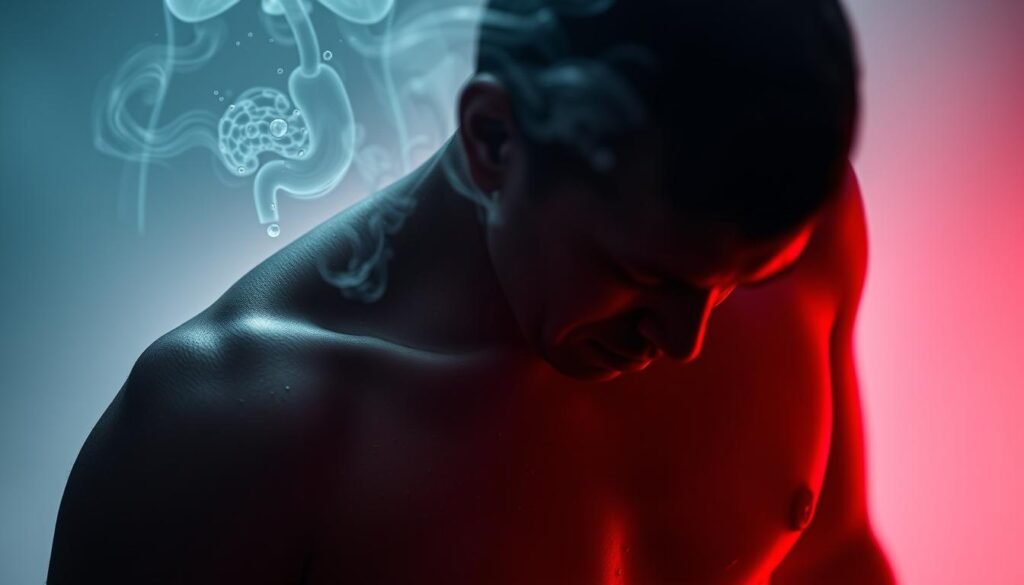About 3% of U.S. adults, especially women, deal with panic disorder each year. This fact shows how closely anxiety disorders and heart health are linked. It’s very important for people to know their symptoms well. Often, what seems like a heart attack might actually be a panic attack. This confusion can be risky. Learning to tell these conditions apart can help people get the right medical help fast.
In this piece, you’ll learn about heart and anxiety attacks. You’ll discover what symptoms to look for. You can also take an anxiety quiz to better understand these issues. We aim to help you tell the difference between these dangerous situations. This will keep you safe and healthy.
Key Takeaways
- Recognizing the symptoms of heart attacks and anxiety is crucial for timely treatment.
- Women often experience symptoms that differ from traditional heart attack signs.
- Anxiety disorders are widespread, particularly among women, with significant implications for heart health.
- Chronic stress can raise the risk of heart problems, further complicating symptoms.
- Participating in an anxiety quiz can help assess one’s symptoms and risks.
Understanding Heart Attacks
A heart attack happens when the heart doesn’t get enough blood. This is often because of coronary artery disease. This condition makes arteries narrow or blocked by cholesterol and fats, cutting down blood flow. The Centers for Disease Control and Prevention (CDC) says heart attack pain feels like chest pressure or squeezing.
Sudden symptoms like arm or shoulder pain, nausea, weakness, and breathing trouble are emergency signs. They mean you need help right away.
Heart attacks have several risk factors. Smoking, high cholesterol, and high blood pressure increase heart attack chances, says the CDC. Anxiety disorders, interestingly, make heart problems 52% more likely.
About 805,000 Americans have a heart attack each year. Your lifestyle choices matter a lot in preventing this. Eating better, exercising, and handling stress well can help avoid heart disease.
Knowing symptoms and acting fast can save lives. Feeling full or discomforted in the chest, along with jaw or back pain, means call 911. The American Heart Association emphasizes recognizing warning signs. Quick action minimizes harm, showing why it’s vital to know about heart attacks and related mental health issues.
Signs and Symptoms of a Heart Attack
Knowing how to spot a heart attack is key for quick help. Knowing these signs can change outcomes. Signs include chest pain, fast heartbeat, and others that need fast help.
Common Symptoms to Watch For
Heart attack signs differ from person to person. Here are key symptoms:
- Chest Pain: Feels like pressure or squeezing. Can spread to arm, jaw, or back.
- Rapid Heartbeat: A heart that beats very fast. This can make you feel dizzy.
- Shortness of Breath: This means having a hard time breathing, with or without chest pain.
- Nausea or Vomiting: Feeling sick or throwing up can happen.
- Excessive Sweating: Sweating a lot is common with these signs.
If you have these signs and they’re not normal for you, get help. Consider them signs of a heart attack and don’t wait.
When to Seek Immediate Medical Help
If you think you’re having a heart attack, get help right away. Every year, about 805,000 Americans have a heart attack. This shows why knowing is vital.
- Persistent chest pain that lasts more than a few minutes.
- Symptoms that come and go instead of fading away.
- Discomfort in the upper body along with other signs.
- Feeling a sudden, intense fear or dread.
Even without usual risk factors, heart attacks can happen. Knowing the signs is important. Quick help can save lives when you can’t tell if it’s anxiety or a heart attack. Being informed lets people act fast when needed.
Recognizing Anxiety and Panic Attacks
Anxiety is a feeling many people know well. It includes worry, fear, and nervousness. Some people face intense levels that mess with their day-to-day lives. Panic attacks are severe forms of anxiety. They happen suddenly and fill a person with intense fear for minutes. Symptoms like fast heartbeat, difficulty breathing, and chest pain can feel like a heart attack.
How often people have panic attacks can vary a lot. Some face them often, while others worry about the next one. Both our genes and our surroundings can make panic attacks more likely. Knowing these details helps in spotting the signs of anxiety and panic attacks.
Identifying panic disorder needs a careful look because it shares symptoms with other conditions. It’s diagnosed when someone has many unexpected panic attacks and worries about having more. A mental health expert can help make this clear.
To manage anxiety and panic attacks, different treatments are used. It could be therapy, medicine, or self-help methods like meditation. A mix of these can give people their lives back. Acknowledging the signs of anxiety and panic helps in finding the right support. This can greatly improve one’s life.
| Symptom | Description |
|---|---|
| Rapid Heart Rate | A noticeably fast heartbeat during an anxiety or panic attack. |
| Trouble Breathing | Difficulties in breathing often perceived as suffocation. |
| Chest Pains | Discomfort or pain in the chest area that can mimic heart attack symptoms. |
| Sweating | Excessive sweating that can occur even in cool environments. |
| Dizziness | Lightheadedness or a feeling of faintness experienced during episodes. |
| Trembling | Shaking or trembling of the hands or body due to intense fear. |
| General Anxiety | Ongoing feelings of unease that persist outside of panic attacks. |
Symptoms of Anxiety Disorders
Anxiety disorders mimic physical health problems, especially those concerning the heart. Knowing these signs helps manage and treat them. Anxiety makes people experience recurring panic attacks. These include many physical symptoms.
How Panic Attacks Feel
Panic attacks can come suddenly, bringing intense fear. People often feel:
- Increased heart rate
- Chest tightness or pain
- Dizziness and lightheadedness
- Stomach discomfort
- Extreme feeling of hot or cold
- Tingling in fingers and toes
During these times, the fear of dying or losing control can be strong. Panic attacks peak quickly but feel very intense. They show how closely anxiety and heart health are linked.
Overlapping Symptoms with Heart Attacks
Anxiety and heart attack symptoms often seem similar. This similarity can confuse people. Key symptoms shared are:
| Symptom | Anxiety Disorders | Heart Attacks |
|---|---|---|
| Chest Pain | Commonly reported as tightness | Described as heavy or crushing |
| Heart Rate | Often dramatically increased during panic | Elevated due to stress on the heart |
| Dizziness | Frequent, especially during panic attacks | May indicate low blood flow |
Knowing these shared symptoms is vital. It helps people seek help faster. This boosts their heart health and mental well-being.

The Heart Attack or Anxiety Quiz
This quiz tells you if your symptoms are more like a heart attack or anxiety. It’s a helpful way for people to understand what they’re feeling. Knowing the difference is key to taking care of your health right.
By taking the quiz, you learn when to seek help or find ways to feel better. If the results show heart attack signs, seeing a doctor right away is crucial. But if it’s anxiety, knowing mental health options can help you manage.
Knowing about your health before anything goes wrong is super important. This quiz lets you take charge of your health early. It helps you know if what you’re feeling is from your heart or your mind. This leads to making smarter health choices.
Distinguishing Between Heart Attack and Panic Attack
It’s crucial to understand the differences between a heart attack and a panic attack. Both can cause chest pain, but how it feels can be different. This knowledge can help decide if you need urgent medical care.
Characteristics of Chest Pain
A heart attack might feel like pressure or a heavy feeling in the chest. This type of pain usually lasts more than a few seconds. On the other hand, a panic attack might cause sharp chest pain. Knowing these signs can be lifesaving.
Duration and Onset of Symptoms
How long symptoms last can tell a heart attack apart from a panic attack. Heart attack symptoms get worse over time and last longer. Panic attacks hit fast and end quickly. Spotting these patterns can guide urgent care decisions.
Common Physical Symptoms: What to Look For
Knowing the physical signs is key in telling heart attacks from anxiety disorders apart. Both can have similar signs, which makes it hard to know what to do. Knowing the signs means you can get help fast or know if it’s just anxiety.
- Nausea: Nausea can happen with both heart attacks and anxiety. With heart attacks, it might come with other signs like hard breathing.
- Shortness of Breath: This can happen during both a heart attack or an anxiety attack. If breathing is hard for a while, you need to get help.
- Rapid Heartbeat: Anxiety can make your heart beat fast, just like a heart attack. It’s key to see if other scary signs are there too.
- Sweating: Too much sweating can be a sign of either a panic or heart attack. This is a warning sign that needs more checking.
It’s very important for people to know their own signs. A 2019 study found that over 77% of people went to the emergency room for chest pain from a panic attack, not a heart problem. This shows a lot of people mix up anxiety with more serious conditions.
Panic attacks usually hit their worst point in about 10 minutes. Heart attack signs can last for hours and vary from person to person. For example, women might feel neck pain, back pain, or have trouble breathing with heart attacks.
Knowing the difference between these conditions is crucial. Understanding when to get help can really change the outcome for both anxiety and heart health. People should watch their bodies closely and talk to a doctor if they’re unsure, especially if signs keep up or get worse.
| Symptom | Heart Attack | Anxiety Disorders |
|---|---|---|
| Nausea | Yes | Yes |
| Shortness of Breath | Yes | Yes |
| Rapid Heartbeat | Occasional | Common |
| Sweating | Yes | Yes |
| Duration | Hours | Approximately 10 minutes |
The Role of Sweating and Fatigue in Both Conditions
Heart attacks and anxiety disorders share common symptoms like sweating and tiredness. It’s essential to understand these signs for quick help. Sweating can be heavy in both cases, making people uncomfortable and worried.
Fatigue often goes hand in hand, making you feel weak and sick. Knowing when these symptoms show up helps tell heart issues and anxiety apart.
Understanding Dizziness and Nausea Symptoms
Dizziness and feeling sick are common in both heart and panic attacks. This can be scary. You might feel shaky and like you’re going to faint.
Suddenly feeling nauseous is also common and can make you want to see a doctor right away. Watching these symptoms is vital, especially if you also feel sweaty or very tired. They might mean you need to get checked by a doctor.

Demographics and Incidence Rates
Understanding heart disease and anxiety disorders is key to tackling health challenges. Various studies show how these affect different groups of people.
Heart disease mainly impacts those over 65, but it’s also growing in younger adults. Around 20-30% of young adults after heart issues report anxiety. It shows we must watch mental health closely.
Approximately 32% of heart failure patients feel more anxious. And about 13% have an anxiety disorder. Before heart surgery, around 25% of patients feel anxious.
| Condition | Incidence Rate of Anxiety |
|---|---|
| Advanced Heart Failure (requiring LVAD) | 20% |
| Patients with ICD Implantations | 20-40% |
| Generalized Anxiety Disorder (CAD Patients) | 11% point prevalence |
| Panic Disorder Prevalence (CAD Patients) | 5-50% |
Anxiety in heart patients leads to more risks. Anxiety can increase coronary disease risk by 26%. People with Generalized Anxiety Disorder have more heart events.
Knowing these facts helps doctors create better care plans. They can focus on heart disease and mental health together.
The Connection Between Anxiety and Heart Health
Anxiety affects heart health more than some realize. About 11 percent of people will face general anxiety disorder in their life. This common mental health issue can cause fast heart rate, abnormal beats, feeling faint, and chest pain. These can also be heart disease symptoms, so it’s vital to tell them apart.
Anxiety raises stress hormones like adrenaline and cortisol. High levels over time can up the risk of heart diseases. Studies show that 50% of those with chest pain in the emergency room don’t have heart problems. Instead, 30-40% have issues related to anxiety. Tests like electrophysiology studies are important for checking the heart.

Long-term anxiety can also increase the chance of high blood pressure. A statistic shows one in four adults may get atrial fibrillation, raising stroke risks. Thus, it’s important to address both mental and physical health issues.
It’s critical to know the difference between anxiety and heart disease symptoms. Chest pain from anxiety usually doesn’t spread. For extra information, reading about their similarities might help.
Conclusion
It’s key to know the difference between heart and anxiety attacks for good health management. Recognizing symptoms helps lower risks from both conditions. Anxiety attacks may feel like heart troubles, so it’s vital to get checked if unsure. This heart attack awareness can save lives by leading to quick help.
Educating people about anxiety is crucial. Understanding panic and anxiety signs helps us manage our health better. By adopting healthy habits and therapy, we can control anxiety. This way, we can tell apart different health issues and improve our well-being.
Kits like the Heart Attack or Anxiety Quiz teach us about health choices in emergencies and daily life. Knowing more makes us healthier, less anxious, and ready to seek help when needed. Focusing on learning about anxiety and heart health brings better health and empowerment.